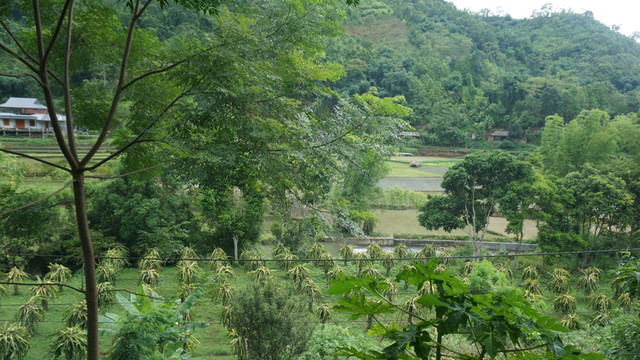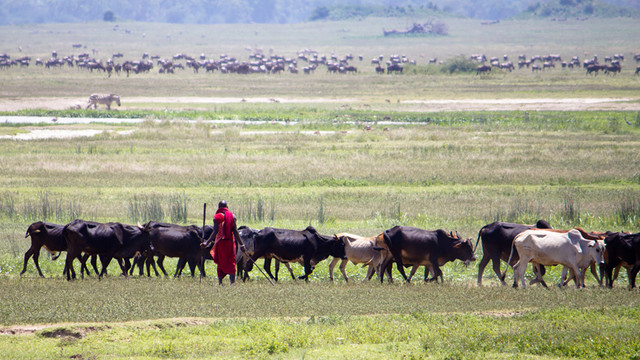LIFE-AR: Uganda roll-out progresses to district level, charts path for more countries to come on board
The LIFE-AR initiative led by the least developed countries (LDCs) shifts power to the local level, making communities the key agents in driving climate-resilient societies. Uganda’s move to embed the innovative programme at district level offers valuable experience and lessons for other LDCs interested in joining the initiative.

The launch of district-level pilot under the LIFE-AR work took place in Pader district in northern Uganda, and included a field visit to a fish farm to learn how communities are adapting to climate change through locally led investments (Photo: copyright LIFE-AR secretariat, Ministry of Water and Environment, Uganda)
The least developed countries (LDCs) have contributed least to escalating climate change yet suffer the most from its impacts. Furthermore, traditional business-as-usual approaches to climate action – top-down, short-term climate projects, operating in silos with high transaction costs and that rely on external expertise – are not working for the LDCs.
The ambitious and innovative Least Developed Countries Initiative for Effective Adaptation and Resilience (LIFE-AR) marks a radical shift towards ‘business unusual’.
The LDC-led and LDC-run initiative enables countries to bring their deep, country-specific experiences into tackling the climate crisis. Principals of inclusive governance and decision-making lie at the core of LIFE-AR.
Perhaps most crucially, LIFE-AR aims to get 70% of climate finance to the local level so the needs of communities most impacted by climate change are met.
Countries decide approach
Mechanisms adopted under LIFE-AR will support countries achieve the LDC 2050 Vision, shaped around climate-resilient people, landscapes and economies. Examples of these mechanisms might include social protection funds that help communities respond to climate shocks or to access basic services following extreme climate events, climate finance investments in landscape/ecosystem management, or innovation funds to promote resilient production systems.
The design of these mechanisms will be informed by national priorities, and align with national climate change and development strategies, plans and policies.
Uganda is one of LIFE-AR’s six ‘frontrunner’ countries and opted to promote a decentralised climate finance (DCF) mechanism – complementing the country’s decentralised governance structure. By using these existing structures, climate finance can be funnelled down to governments at the local level and out to communities who are hardest hit by the impacts of climate change.
Uganda: district level roll-out begins
The objective of Uganda’s DCF mechanism is to strengthen local government planning and finance systems to deliver climate-resilient development in Uganda. Local communities will get to decide which adaptation interventions are funded through DCF in line with their needs and priorities.
Buy-in and ownership of the programme has continued since last year’s national launch. Now, roll-out has begun at district level with 12 pilot districts ready to test the innovative features of the DCF mechanism, set up during the establishment phase.
Communities voice priorities
The official district-level launch took place in Pader district in northern Uganda.
The event embraced LIFE-AR’s ‘whole-of-society’ approach whereby input into programme design and delivery comes from the broadest possible cross-section of society. Joining the launch were politicians from the participating pilot districts, representatives from relevant government ministries, departments, and agencies (MDAs), civil society organisations and the private sector as well as from youth organisations, women’s organisations, religious and cultural institutions and people with disabilities.
Some examples of suggestions from communities on where they would like money to be invested included: micro-scale irrigation systems; ecological fish farming/cage fish farming; apiculture (bee keeping); fragile ecosystems restoration (including restoration of bare hills, lakeshores, riverbanks, and wetlands); water supply infrastructure; weather stations; establishing and managing tree nursery beds; tree planting (afforestation/woodlot establishment, agroforestry and boundary tree planting); energy saving cook stoves; community roads; waste management; and biogas technologies.
Knowledge and power in the hands of local actors
LIFE-AR stresses the importance of full ownership and accountability of the initiative at local level. But the right capacity, knowledge and structures must be in place to support this ownership.
A capacity needs assessment of the pilot districts has already been undertaken, highlighting key gaps and needs around climate information, governance, planning, finance, gender and social inclusion among others.
In addition to addressing the emerging gaps and needs in local government institutions, staff will also be trained on the ‘business-unusual’ approach to LIFE-AR and on the delivery mechanism itself − how it works and is implemented.
At the launch, Alfred Okot Okidi, permanent secretary of Uganda’s Ministry for Water and Environment, explained: “LIFE-AR is ready to deliver all the training and finance necessary. It’s then up to the local governments to own and drive implementation of the programme and involve all stakeholders.
"We want to build strong capabilities and structures for climate action at all levels that can drive participatory planning for climate action in line with local knowledge, contexts and priorities – without relying on national or external support.”

Alfred Okot Okidi, of Uganda’s Ministry for Water and Environment, plants a tree at the Pader district headquarters to symbolise the start of implementation of LIFE-AR at district level in Uganda (Photo: copyright LIFE-AR secretariat, Ministry of Water and Environment, Uganda)
Patient roll-out, strong foundations
One aspect of LIFE-AR that sets it apart from other climate and development initiatives is the pace of roll-out: getting to district-level phase has taken about three years.
There is often pressure from donors and politicians for rapid roll out of initiatives, which prioritises short-term outputs over lasting, positive impacts for local communities, undermining both development and climate outcomes for LDCs.
In contrast, the pace of establishing LIFE-AR has been deliberately steady. This has enabled the laying of robust foundations, in particular to ensure all the right systems are in place for managing funds and for promoting participatory planning, robust governance, and accountability and transparency at local government level.
Parish-level committees will ensure direct link to villages
LIFE-AR is guided by the principles of inclusion, participation, justice and equity. It is fundamental that the programme’s structures support these principles to ensure outcomes are truly community driven and that communities lead both in decision making and implementation.
LIFE AR presents an opportunity for strengthening the government’s decentralisation policy, and to move away from top-down ways of doing business that are not fit for purpose.
Recognising the need to connect with society at village level, a next key stage for the initiative is to establish Parish Climate Change Committees. Since parish level sits closest to village level in terms of administrative structures, such committees will ensure that needs and priorities of people from the villages it represents are heard, and so can inform how and where climate finance is invested.
Scovia Akot, of the ministry’s climate change department, said: “the launch at district level is not only important for ownership and buy-in of the programme from the local actors, but also improves local understanding of the programme. Additionally, it will encourage new and local perspectives that will help us shape the programme in the interest of the grassroot communities – and it is the needs and priorities of these communities for which LIFE-AR has been designed.”
LIFE-AR calls for a shift towards ‘business-unusual’. Read more about ‘business-unusual’ and what it looks like in practice.
For more information about LIFE-AR, including how different delivery mechanisms can work for different LDCs, contact lilian.motaroki@iied.org.



